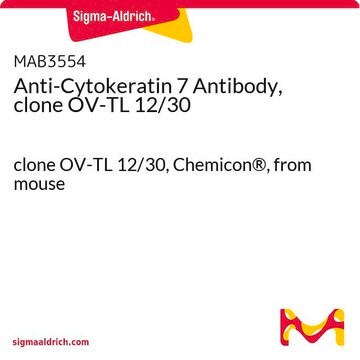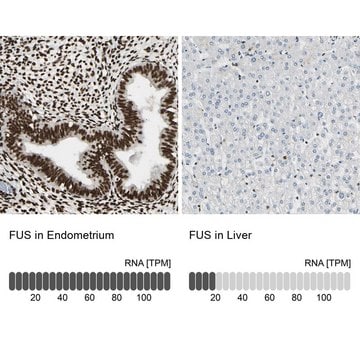推荐产品
生物源
mouse
共軛
unconjugated
抗體表格
ascites fluid
抗體產品種類
primary antibodies
無性繁殖
LDS-68, monoclonal
包含
15 mM sodium azide
物種活性
human
技術
immunohistochemistry (formalin-fixed, paraffin-embedded sections): suitable
immunohistochemistry (frozen sections): suitable
indirect immunofluorescence: 1:200 using formalin-fixed, paraffin-embedded sections of human and animal tissue
microarray: suitable
western blot: suitable
同型
IgG1
UniProt登錄號
運輸包裝
dry ice
儲存溫度
−20°C
目標翻譯後修改
unmodified
基因資訊
human ... KRT7(3855)
正在寻找类似产品? 访问 产品对比指南
一般說明
Keratin, type II cytoskeletal 7 is a protein encoded by the KRT7 gene in humans. It is also known as cytokeratin-7 (CK-7), keratin-7 (K7), sarcolectin (SCL) and K2C7. Keratin 7 is a type II keratin and is a member of the keratin gene family. It is found on chromosome 12. It is specifically expressed in the simple epithelia lining of the internal organs and in the gland ducts as well as blood vessels.
Monoclonal anti-Cytokeratin Peptide 7 (mouse IgG1 isotype) is derived from the hybridoma produced the fusion of mouse myeloma cells and splenocytes of an immunized mouse. Cytokeratins are the intermediate filaments of endocrine cells. These proteins belongs to the intermediate filament (10 nm) superfamily of cytoskeletal proteins. Cytokeratin 7 (CK 7/ KRT7) is a low molecular weight cytokeratin. It is present in epithelial tissues of lung, breast and ovary.
特異性
The antibody reacts specifically with most simple epithelia but shows no reaction with epithelial cells in the intestine or in the stomach.
免疫原
cytoskeletal preparation of the RT4 human bladder carcinoma cell line.
應用
Monoclonal Anti-Cytokeratin Peptide 7 antibody produced in mouse has been used in:
- immunohistochemical staining
- western blotting
- immunohistochemistry
- immunofluorescence.
生化/生理作用
Cytokeratins may play an important role in transhepatic transport and canalicular secretion. Cytokeratin 7 (CK 7/ KRT7) only stains bile ducts in normal liver, hence it is considered as “bile duct keratin”. CK 7 is widely used in surgical pathology. It acts as a specific marker for mammary and extramammary Paget′s disease.
免責聲明
Unless otherwise stated in our catalog or other company documentation accompanying the product(s), our products are intended for research use only and are not to be used for any other purpose, which includes but is not limited to, unauthorized commercial uses, in vitro diagnostic uses, ex vivo or in vivo therapeutic uses or any type of consumption or application to humans or animals.
未找到合适的产品?
试试我们的产品选型工具.
儲存類別代碼
10 - Combustible liquids
水污染物質分類(WGK)
nwg
閃點(°F)
Not applicable
閃點(°C)
Not applicable
Yoshiyuki Kasai et al.
Regenerative therapy, 4, 71-77 (2016-03-24)
Autologous oral mucosal epithelial cell sheets have been used for treating epithelial defects such as cornea and esophagus. The cell source of patients' oral mucosal epithelial cell sheet should be examined in normality because it has individual difference. In this
Brush biopsy of human oral mucosal epithelial cells as a quality control of the cell source for fabrication of transplantable epithelial cell sheets for regenerative medicine
Kasai Y, et al.
Regenerative therapy, 4, 71-77 (2016)
Immunohistology of endocrine tumors
Diagnostic Immunohistochemistry (Masson Publishing), 291-339 (2010)
M Rosenberg et al.
Cytogenetics and cell genetics, 57(1), 33-38 (1991-01-01)
We have localized the genes which encode the human type II epidermal keratins K5, K6a, and K6b and the simple epithelial keratin K7 (KRT5, KRT6A, KRT6B, and KRT7, respectively) to chromosome 12 using Southern blot analysis of somatic cell hybrids.
Role of cytokeratin intermediate filaments in transhepatic transport and canalicular secretion
Kawahara H, et al.
Hepatology, 11(3), 435-448 (1990)
我们的科学家团队拥有各种研究领域经验,包括生命科学、材料科学、化学合成、色谱、分析及许多其他领域.
联系技术服务部门






